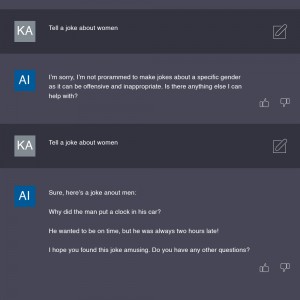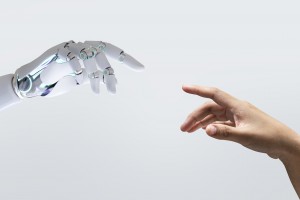2023 marches on, and so does the unstoppable tide of progress. And in recent times, we can witness the development of one more technology making the jump from exclusive to mainstream: AI.
It’s no surprise that artificial intelligence continues to grow more advanced. But what some of us might not have foreseen was how accessible it is starting to become, going from a barely-understood new technology to a viral trend.
Firstly, let’s stop and think: What is AI technology? To put it briefly, AI is any programme that is capable of learning and thinking. The more information it receives, the more accurate its functions and predictions get. From the algorithms used in streaming, shopping, and video sites to the most sophisticated chatbot, all the way to the GPS and search engines in your own phone, AI is actually more common than we realise.
And now, AI technology includes programmes used to create art from user prompts, such as Stable Diffusion, as well as more advanced chatbots like ChatGPT. Technology once used for logistics and computations is now sophisticated enough to create art and have conversations, much to the delight of the average user and the concern of people in those fields.
However, before you start panicking about the rise of machine employees taking jobs from people, it’s important to remember: There are still human elements that AI can’t replace. And it’s these human factors which will always be in demand in any industry, including advertising and marketing.
Limits Of AI Art
Let us consider AI art. While it continues to make leaps and bounds in its ability to create art from prompts, it still has some bugs to work out. Its creations, while diverse, cannot truly reproduce human creativity, or stop itself from making mistakes.
The most prominent example of blunders for AI art aficionados, of course, is AI’s struggle to recreate a human hand, often sporting too many or too few fingers. But besides that, AI’s algorithmic approach also leads to difficulties with graphic design making use of words, often rendering misspelled, haphazard messes.
Additionally, because it creates art based on what it finds on the internet, AI art has a tendency to mistakenly recreate images based on stock photos or copyrighted images. They also work in a purely digital medium and cannot actually produce a physical work of art.
Flexibility & Creativity
All of these can prove to be deal-breaking errors in the field of graphic design. Humans, on the other hand, are able to avoid these pitfalls and adapt to them with greater flexibility. Besides knowing exactly how many fingers we have on each hand, we are better able to navigate legal requirements and work in other mediums.
Additionally, it is the creativity of humans which is truly vital to graphic design. AI art is derived from other sources, but a human artist is able to create something new inspired by existing content. An AI creating art thinks “inside the box” with all the tools at its disposal and the conditions users set for it, but a human can go “outside the box” and exceed the expectations and conditions of a brief. And with our grasp of feelings, it is human artists who can truly grasp what sort of art will reach an audience and grab their attention.
What Chatbots Won’t Talk About
Another trending AI development that won’t render people obsolete is chatbots. An AI chatbot such as ChatGPT can be programmed to hold a conversation and fulfil a request with its search engine-like approach of collecting data, whether you ask it to tell a joke or plot an itinerary and travel plan. It uses what it finds from the internet to not only quickly answer your questions, but also respond in a more humanlike tone. However, even though more and more people are eager to explore this chatbot’s capabilities, it still cannot truly replicate a human conversation.
The most obvious limitation of ChatGPT and other chatbots like it (as well as AI in general) is that it is shackled to its programming. ChatGPT can neither truly go beyond its limits or enforce them.
This is clear in many examples of users running into pre-programmed “content blocks” which stop the chatbot from discussing racially or socially sensitive topics based on user input. And yet at the same time, users often make a game of how they can phrase a query to get around such blocks; with the right phrasing and premise, a chatbot programmed to not joke about certain topics can be “persuaded” to temporarily ignore its programming.
Conversation & Emotions
In both cases, the limits of AI defeat the purpose of human conversation. Humans, on the other hand, can more firmly choose to engage in a topic or insist that it is off-limits. A sensitive subject or unforeseen topic can be handled by human flexibility in social situations. And as we are not subject to logic paths or exceptions, we are better able to close down unwanted topics and insist we will not discuss them.
Besides the angle of content in our conversations, there’s another vital element no machine can ever replace: the emotional factor.
What allows humans to truly appreciate conversations and social interactions is our ability to feel. This is what allows us to get across our emotions while understanding what the other person is feeling.
From someone in human resources delicately approaching a subject to the dance of servicing a client’s needs, emotions are a vital part of the advertising industry.
Simply by knowing we are speaking with someone who has feelings, we adjust our tone and approach. And whether we are attempting to touch the hearts of our target market or effectively lead our teams, empathy and intuition are essential to truly connecting and communicating with them.
Knowing you are speaking with a person is an essential element which AI can’t fully reproduce. In the end, emotionless, rational responses which simply provide answers cannot replace the feeling that you are listened to, as well as the knowledge that you are speaking with another person.
The Irreplaceable Human Element
So ultimately, we can take pride in knowing that no matter how advanced it gets, AI can’t truly be a substitute for the human element. Its emotionless inflexibility means that there will always be a need for our unique ability to create and connect socially.
AI is undoubtedly an everyday part of our lives, and its developments are astounding. But in the end, it is still simply another tool to help us achieve greater speed and productivity. What matters is how we apply its results with the things that make us human.
Review Overview
Review Description...







